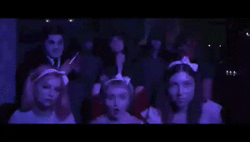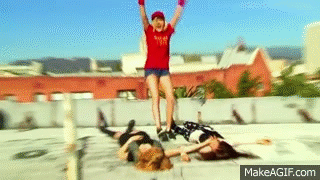Jonathan V. Last's Blog, page 18
March 25, 2015
Best Action Movie Franchise Ever? Science!
Because my Mission: Impossible post is a like a splinter in your brain, Santino has decided to use The Science to figure out which action movie franchise is really the best of all time. There are charts and numbers and deltas.
Go. Right now. It’s awesome.
And let this be a lesson to all about the limits of Science to reveal deep truths: Santino’s rankings say that the Bourne movies are the best action franchise ever, and that the Rambo movies rank above Indiana Jones and the Alien series.
#philosophy>science
March 24, 2015
About ‘Mission: Impossible’
Got a couple slightly skeptical emails about this Mission: Impossible post, so I thought it might be worth unpacking my claim a little bit.
When we talk about action-movie franchises, what’s even in the running? Here’s a short, and incomplete, list:
Die Hard
Speed
Lethal Weapon
James Bond
Bourne
Rambo
Rocky
Terminator
Aliens
Predator
Non-Nolan Batman
Transformers
Indiana Jones
Fast and Furious
There’s lots of gray zone here. I wouldn’t include the Nolan Batman movies as an “action franchise” because I view them as a self-contained trilogy, telling a single, distinct story. (In the same way I wouldn’t count Lord of the Rings, or Hunger Games, as a “franchise.”) I would, however, count the non-Nolan Batman flicks. To me, a franchise is a series where they make movies not to fit a contained narrative arc, but to fit the demands of the marketplace. Make sense? And it needs to have at least three entries.
And when we talk about action-movie franchises, I’m not entirely certain if it’s fair to commingle science-fiction with straight action. Can we look put the Lethal Weapon movies and the Terminator movies under the same category header? I can see it both ways. But for the purposes of this discussion, let’s say yes.
This list–and again, I’m sure you have entries I’ve left out (does “Marvel” count as its own franchise? How about just “X-Men”?)–is made up of mostly superior franchises. Just about every franchise listed has at least one classic movie in it. After all, that’s typically how a franchise starts: The studio strikes gold with a great movie and then milks it for as long as the good will lasts with audiences while the product quality diminishes.
I’d argue, for instance, that Raiders and Die Hard are both seriously great and seriously important and influential films, both better than any of the Mission: Impossible movies. If you’re making a list of the 50 greatest movies of the last 40 years, it would be very hard leave either of them off of it. But the rest of those franchises were not so great. Terrible, even. Because the cool kids all obsess about Shia and nuking the fridge, they’ve forgotten about Short Round. We must never forget Short Round.
For my money, what makes the M:I movies so great is the following:
* The original M:I is an amazing piece of work; one of the best grown-up action movies ever made.
* The series has the highest consistent level of quality of any of the franchises.
* Yet it achieves this quality control under very different regimes. The Brad Bird M:I is a very different animal from the De Palma M:I which is very different from the Abrams M:I. It’s a sign of how variegated they are that there’s not “M:I thing” that audiences enter the theaters looking for. There’s no trope–a Bond girl, or a Rocky come back–that audiences expect from an M:I movie. (Except, maybe, that they damn well better see Tom Cruise running.)
* The delta between the series high and the series low in M:I is relatively small. On our list, the smallest deltas would be for Lethal Weapon (because the series low, 4, wasn’t all that terrible) and for Transformers (because the series high, the original, wasn’t great to begin with). M:I 2 is a dud, but not offensively so. It’s not Die Hard 2. It’s not Live and Let Die.
So, resolved: Pound-for-pound, Mission: Impossible is the best action-movie franchise of all time.
March 23, 2015
First Look at ‘The Dadly Virtues’
Trailer City
I’ve said it before and I’ll say it again: Pound-for-pound, the Mission: Impossible series is might be the best action franchise ever. One absolutely great, total classic. One really great, instant classic. One pretty heavy thriller. And only one dud. I’ll put it up against anything from the last 30 years, even the Jack Ryan movies.
In other words, Mission: Impossible: Rogue Nation? I’m in.
Who is that hot ad girl?
Here’s the elevator pitch: “It’s like Snopes.com. But for the hot girls in commercials!”
Why yes. Yes it is.
Incredibly problematic, of course. That should go without saying.
But also, kind of awesome.
(And a cautionary tale about how terrifyingly Darwinian the entertainment industry is for women in their early twenties.)
March 19, 2015
And then we were all like . . .

That’s just for Galley Friend B.F. I’m heading to Instagram next.
(And you people still haven’t thanked me for Wrestling Isn’t Wrestling. I’m waiting.)
March 18, 2015
White Stuff People Hate
#2: Fat white people. Here’s hip-hop star Azealia Banks keeping it real:
“Like, I hate fat white Americans. All the people who are crunched into the middle of America, the real fat and meat of America, are these racist conservative white people who live on their farms. Those little teenage girls who work at Kmart and have a racist grandma—that’s really America.”
Greatest GIF Ever?
Portrait of a Useful Idiot
I’m not sure what the real scandal is here: That we have a state-college full professor dumb enough to believe that the CIA “gave” Hugo Chavez cancer, or that Penn State – Abington considered “Women’s Agency In Hysteria and Its Treatment” and “Defending the Self In a Total Institution: Staff Prompting and Patient Burlesque” to be actual academic credentials.
Either way, you cannot miss this interview with Penn State Professor Karen Halnon. Sample awesome:
Can you comment on your arrest and on the videos of you on the plane that are circulating?
I do have a comment. I know that I expressed an act of civil disobedience. But that act was necessary.
Why so?
I’m very knowledgable about that part of the world. I teach about U.S. imperialism in Latin America. And the U.S. has declared war against Venezuela. That means military aggression. They tried to take out Hugo with a coup, and then they took him out with cancer. . . .
What is the revolution revolting against?
The problem is U.S. military global domination. And they want the oil. And they want the water. And so I found that this act was a necessary Thoreau-like act of civil disobedience. I had to speak out now. The situation is dire and urgent, and any sacrifice I make for my own self, if it saves lives — there have been far too many lives lost due to U.S. global military domination. . . .
But what of the cigarette? One reporter who covered your actions said that lighting a cigarette on a plane is just a little better than yelling “BOMB!”
Why did I have a lighter if there is such great national security? It was right in the top of my book bag.
Listen, the point is, I am a sociologist, and I live in an intellectual world. A sociologist always thinks in terms of symbols. And every revolutionary I know smokes. It was identifying with the revolutionary cause. And then, beyond that, it is a symbol that the United States is a smoking gun. The action was necessary. They are going to kill many more people.
She’s like Ward Churchill minus 30 IQ points.
Exit question: Isn’t it problematic that Halnon is accusing our first black president of declaring war on Venezuela?
March 17, 2015
White Stuff People Hate
#1: Books written by white men, and possibly white women. No really, this is a thing:
The internet has been abuzz recently with debates over reading lists and reading habits. Writer K. Tempest Bradford caused a bit of a stir when she challenged readers to stop reading straight white cisgendered male authors for a year. Sunili Govinnage generated her share of outrage when she reported on her year spent deliberately not reading white authors. And in late 2014, the phenomenally successful #WeNeedDiverseBooks campaign took Tumblr and Twitter by storm, sparking a conversation about which books get published and read, and which don’t, and what these choices are doing to children’s literature.
Many of the responses generated by these articles and initiatives have been supportive — even from those white male authors ‘targeted’ for exclusion. Neil Gaiman, whose novel American Gods appears crossed out in red at the top of Bradford’s piece, told “anyone hoping for outrage”that he thought Bradford’s suggestion was “great” . . .





